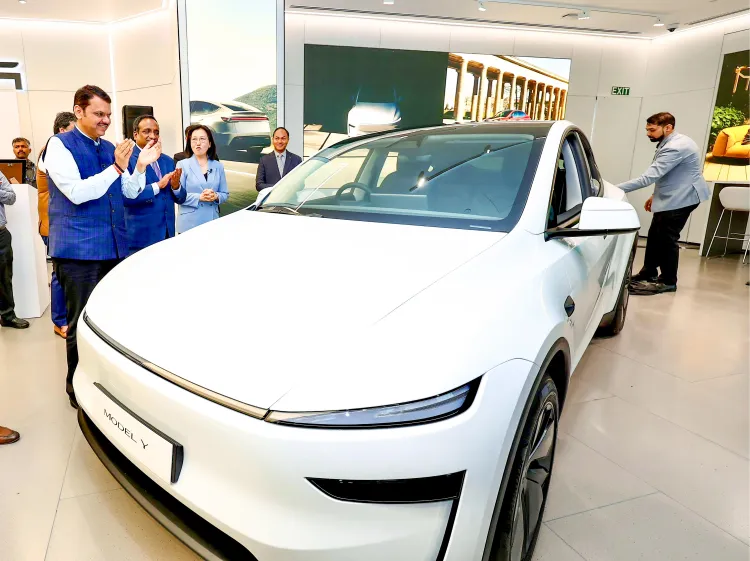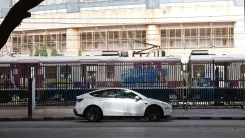Will EV sales in India exceed 7% market share by FY28?

Synopsis
Key Takeaways
- India's EV sales are projected to surpass 7% by FY28.
- Government initiatives are crucial for supporting EV growth.
- Charging infrastructure is expanding rapidly across the country.
- Private sector investments are enhancing the EV ecosystem.
- Standardization of charging protocols is being prioritized.
Mumbai, July 16 (NationPress) The penetration of electric vehicle sales in India is projected to surge significantly, potentially exceeding 7 percent by FY28, contingent on the timely resolution of rare earth element (REE) disruptions. This growth is fueled by the introduction of new models and a government initiative aimed at enhancing the country's charging infrastructure, as highlighted in a recent report released on Wednesday, coinciding with Tesla's long-awaited entry into the Indian market.
Over the last three years, India’s electric vehicle ecosystem has gained substantial momentum, escalating from just over 5,000 units in FY21 to more than 1.07 lakh units by FY25, marking an impressive increase of nearly 21 times, according to the CareEdge Advisory report.
While electric four-wheelers currently represent a minor portion of total EV sales—predominantly led by two and three-wheelers—this segment is entering a period of rapid growth, buoyed by supportive public policies and robust private sector investments.
The Indian government has pledged to achieve a 30 percent EV penetration by FY30 and is actively facilitating this transition.
Programs such as FAME III, the Production Linked Incentive (PLI) Scheme for advanced chemistry cell (ACC) batteries, and exemptions on customs duties for essential battery minerals—including cobalt, lithium-ion waste, and graphite—are anticipated to lower production costs and enhance domestic supply chain resilience, as noted in the report.
“India’s electric car sales penetration is expected to surpass 7 percent by FY28, provided that REE disruptions are addressed swiftly. With a strong lineup of model launches, advancing EV charging infrastructure, and battery localization initiatives under the PLI scheme, India is well-equipped to boost EV adoption,” stated Tanvi Shah, Senior Director and Head at CareEdge Advisory & Research.
The growth of charging infrastructure, once a significant impediment to India’s electric vehicle adoption, is now experiencing unprecedented expansion.
The report indicates that, in the last three years, the number of Public EV Charging Stations (EVPCS) in India has increased nearly 5x, rising from 5,151 in CY22 to over 26,000 by early FY25, demonstrating a robust compound annual growth rate (CAGR) exceeding 72 percent.
The FAME III initiative allocates specific funds for expanding charging infrastructure, while states like Maharashtra, Delhi, Tamil Nadu, and Gujarat have introduced targeted EV infrastructure incentives—ranging from land subsidies to capital expenditure support. These efforts are complemented by urban municipal initiatives that mandate EV-ready parking slots in both residential and commercial areas.
The aim is to ensure that EV drivers can easily locate a reliable charging station every 5 to 10 kilometers in densely populated urban areas, a strategy that effectively alleviates range anxiety, a primary concern among prospective EV purchasers.
The report also highlights that private charge point operators (CPOs) are rapidly expanding their operations, often through public-private partnerships (PPP) with municipal corporations and DISCOMs.
Additionally, policy focus is shifting towards standardization and interoperability, with the Bureau of Energy Efficiency (BEE) and NITI Aayog advocating for uniform protocols across chargers to enhance user convenience.
The recent budget for FY26 introduced zero basic customs duty on 16 key minerals utilized in EV battery manufacturing, further reducing import dependency and production expenses.
CareEdge predicts that India’s reliance on lithium-ion cell imports could decrease to 20 percent by FY27, down from nearly 100 percent in FY22, thanks to ongoing investments in integrated battery manufacturing capacities.









